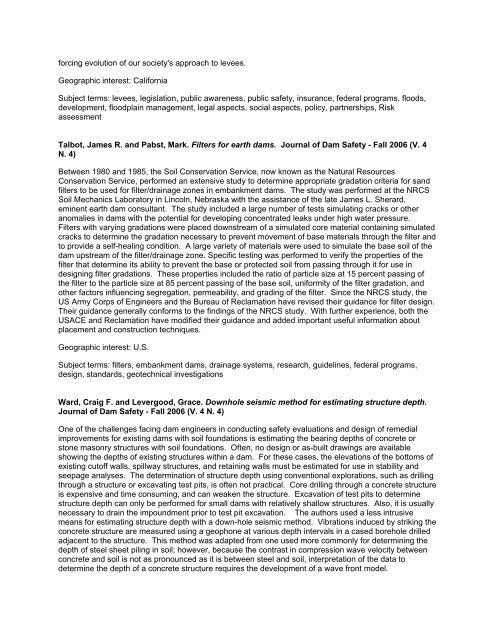Annotated List of Articles Published in the Journal of Dam Safety ...
Annotated List of Articles Published in the Journal of Dam Safety ...
Annotated List of Articles Published in the Journal of Dam Safety ...
- No tags were found...
You also want an ePaper? Increase the reach of your titles
YUMPU automatically turns print PDFs into web optimized ePapers that Google loves.
forc<strong>in</strong>g evolution <strong>of</strong> our society's approach to levees.Geographic <strong>in</strong>terest: CaliforniaSubject terms: levees, legislation, public awareness, public safety, <strong>in</strong>surance, federal programs, floods,development, floodpla<strong>in</strong> management, legal aspects, social aspects, policy, partnerships, RiskassessmentTalbot, James R. and Pabst, Mark. Filters for earth dams. <strong>Journal</strong> <strong>of</strong> <strong>Dam</strong> <strong>Safety</strong> - Fall 2006 (V. 4N. 4)Between 1980 and 1985, <strong>the</strong> Soil Conservation Service, now known as <strong>the</strong> Natural ResourcesConservation Service, performed an extensive study to determ<strong>in</strong>e appropriate gradation criteria for sandfilters to be used for filter/dra<strong>in</strong>age zones <strong>in</strong> embankment dams. The study was performed at <strong>the</strong> NRCSSoil Mechanics Laboratory <strong>in</strong> L<strong>in</strong>coln, Nebraska with <strong>the</strong> assistance <strong>of</strong> <strong>the</strong> late James L. Sherard,em<strong>in</strong>ent earth dam consultant. The study <strong>in</strong>cluded a large number <strong>of</strong> tests simulat<strong>in</strong>g cracks or o<strong>the</strong>ranomalies <strong>in</strong> dams with <strong>the</strong> potential for develop<strong>in</strong>g concentrated leaks under high water pressure.Filters with vary<strong>in</strong>g gradations were placed downstream <strong>of</strong> a simulated core material conta<strong>in</strong><strong>in</strong>g simulatedcracks to determ<strong>in</strong>e <strong>the</strong> gradation necessary to prevent movement <strong>of</strong> base materials through <strong>the</strong> filter andto provide a self-heal<strong>in</strong>g condition. A large variety <strong>of</strong> materials were used to simulate <strong>the</strong> base soil <strong>of</strong> <strong>the</strong>dam upstream <strong>of</strong> <strong>the</strong> filter/dra<strong>in</strong>age zone. Specific test<strong>in</strong>g was performed to verify <strong>the</strong> properties <strong>of</strong> <strong>the</strong>filter that determ<strong>in</strong>e its ability to prevent <strong>the</strong> base or protected soil from pass<strong>in</strong>g through it for use <strong>in</strong>design<strong>in</strong>g filter gradations. These properties <strong>in</strong>cluded <strong>the</strong> ratio <strong>of</strong> particle size at 15 percent pass<strong>in</strong>g <strong>of</strong><strong>the</strong> filter to <strong>the</strong> particle size at 85 percent pass<strong>in</strong>g <strong>of</strong> <strong>the</strong> base soil, uniformity <strong>of</strong> <strong>the</strong> filter gradation, ando<strong>the</strong>r factors <strong>in</strong>fluenc<strong>in</strong>g segregation, permeability, and grad<strong>in</strong>g <strong>of</strong> <strong>the</strong> filter. S<strong>in</strong>ce <strong>the</strong> NRCS study, <strong>the</strong>US Army Corps <strong>of</strong> Eng<strong>in</strong>eers and <strong>the</strong> Bureau <strong>of</strong> Reclamation have revised <strong>the</strong>ir guidance for filter design.Their guidance generally conforms to <strong>the</strong> f<strong>in</strong>d<strong>in</strong>gs <strong>of</strong> <strong>the</strong> NRCS study. With fur<strong>the</strong>r experience, both <strong>the</strong>USACE and Reclamation have modified <strong>the</strong>ir guidance and added important useful <strong>in</strong>formation aboutplacement and construction techniques.Geographic <strong>in</strong>terest: U.S.Subject terms: filters, embankment dams, dra<strong>in</strong>age systems, research, guidel<strong>in</strong>es, federal programs,design, standards, geotechnical <strong>in</strong>vestigationsWard, Craig F. and Levergood, Grace. Downhole seismic method for estimat<strong>in</strong>g structure depth.<strong>Journal</strong> <strong>of</strong> <strong>Dam</strong> <strong>Safety</strong> - Fall 2006 (V. 4 N. 4)One <strong>of</strong> <strong>the</strong> challenges fac<strong>in</strong>g dam eng<strong>in</strong>eers <strong>in</strong> conduct<strong>in</strong>g safety evaluations and design <strong>of</strong> remedialimprovements for exist<strong>in</strong>g dams with soil foundations is estimat<strong>in</strong>g <strong>the</strong> bear<strong>in</strong>g depths <strong>of</strong> concrete orstone masonry structures with soil foundations. Often, no design or as-built draw<strong>in</strong>gs are availableshow<strong>in</strong>g <strong>the</strong> depths <strong>of</strong> exist<strong>in</strong>g structures with<strong>in</strong> a dam. For <strong>the</strong>se cases, <strong>the</strong> elevations <strong>of</strong> <strong>the</strong> bottoms <strong>of</strong>exist<strong>in</strong>g cut<strong>of</strong>f walls, spillway structures, and reta<strong>in</strong><strong>in</strong>g walls must be estimated for use <strong>in</strong> stability andseepage analyses. The determ<strong>in</strong>ation <strong>of</strong> structure depth us<strong>in</strong>g conventional explorations, such as drill<strong>in</strong>gthrough a structure or excavat<strong>in</strong>g test pits, is <strong>of</strong>ten not practical. Core drill<strong>in</strong>g through a concrete structureis expensive and time consum<strong>in</strong>g, and can weaken <strong>the</strong> structure. Excavation <strong>of</strong> test pits to determ<strong>in</strong>estructure depth can only be performed for small dams with relatively shallow structures. Also, it is usuallynecessary to dra<strong>in</strong> <strong>the</strong> impoundment prior to test pit excavation. The authors used a less <strong>in</strong>trusivemeans for estimat<strong>in</strong>g structure depth with a down-hole seismic method. Vibrations <strong>in</strong>duced by strik<strong>in</strong>g <strong>the</strong>concrete structure are measured us<strong>in</strong>g a geophone at various depth <strong>in</strong>tervals <strong>in</strong> a cased borehole drilledadjacent to <strong>the</strong> structure. This method was adapted from one used more commonly for determ<strong>in</strong><strong>in</strong>g <strong>the</strong>depth <strong>of</strong> steel sheet pil<strong>in</strong>g <strong>in</strong> soil; however, because <strong>the</strong> contrast <strong>in</strong> compression wave velocity betweenconcrete and soil is not as pronounced as it is between steel and soil, <strong>in</strong>terpretation <strong>of</strong> <strong>the</strong> data todeterm<strong>in</strong>e <strong>the</strong> depth <strong>of</strong> a concrete structure requires <strong>the</strong> development <strong>of</strong> a wave front model.
















